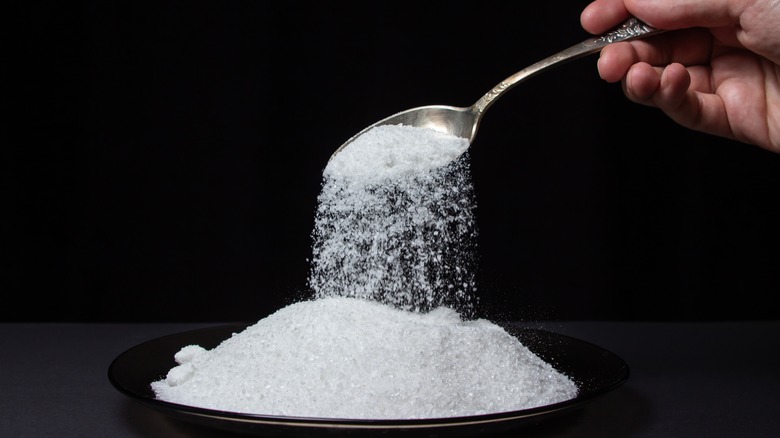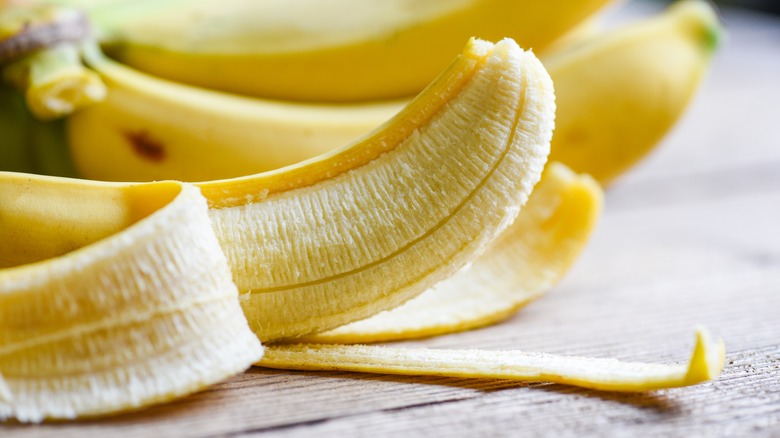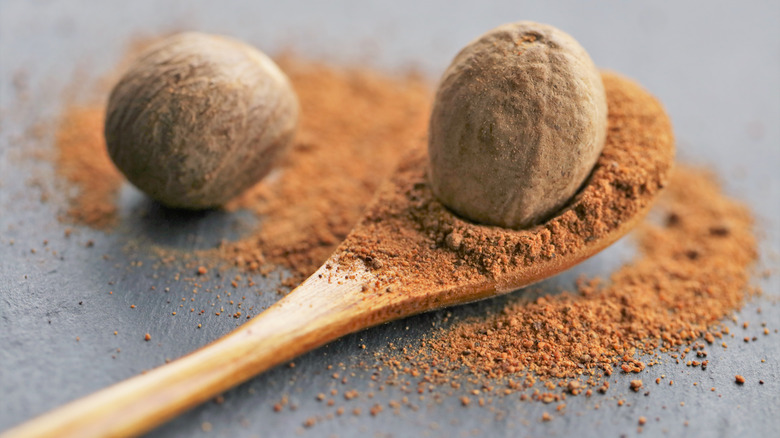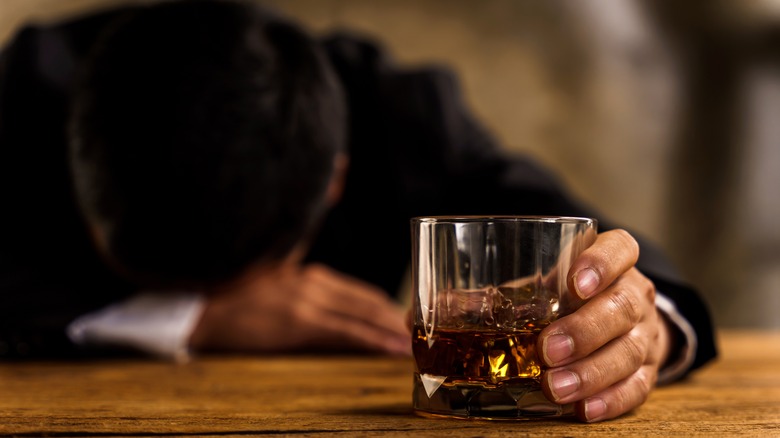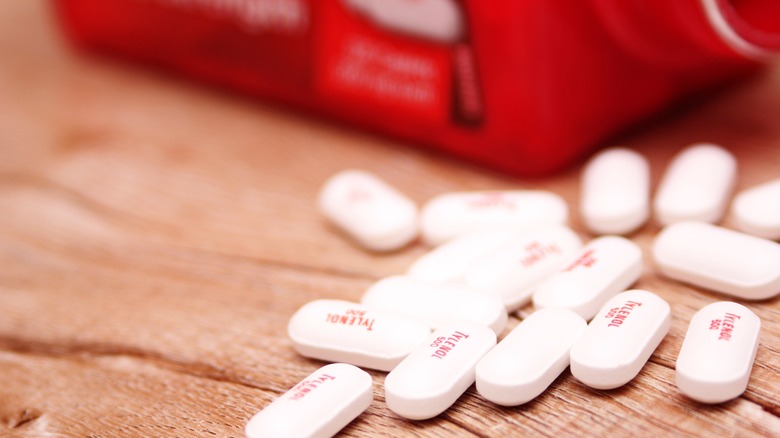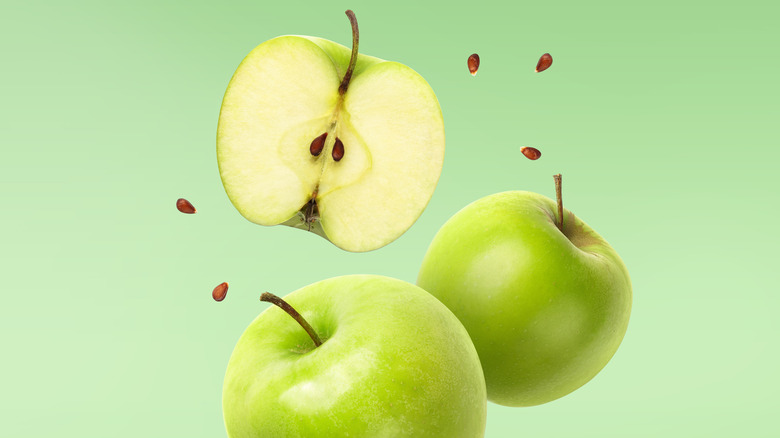Here's How Much You Can Have Of These Regular Things Before They Kill You
Once you start doing some research, one thing becomes almost shockingly clear: There are an uncomfortable number of ways to die. There are the big ones, of course, like cancer and heart disease. But there are plenty of dangers lurking around the house, too. Even things that might not seem deadly definitely can be. Take televisions. While some people are fond of saying that if you sit too close to the television you'll ruin your eyes, that's not actually the biggest danger. According to a report from the U.S. Consumer Product Safety Commission, there were 571 people killed by falling television (and/or furniture) between 2000 and 2019.
Given the number of people who have televisions (and furniture), that's both a surprising stat and slim odds. But it also goes to show that there are some perfectly ordinary things that can cause some devastating deaths — so, let's talk about them.
When it comes to toxicity and how much of a substance can be deadly, there's a big caveat, especially when referring to things that are typically found around the home, in everyday life, and exist in fairly inert forms ... most of the time. Factors such as a person's age and medical history can significantly impact their tolerance for certain substances. Then, there are things like allergies, an individual's genetic tolerances or susceptibilities, the potential for interactions with medications, and so on. So, while exact measurements are often impossible, let's get into it.
Chocolate
It's common knowledge that dogs should never, ever be given chocolate. It's toxic to them because of a substance called theobromine which, according to New York University Langone Medical Center physician Reed Caldwell (via Popular Science), is the same chemical that makes it toxic to humans — just in different doses.
This is where something called the LD50 level comes in. That's a term that's used to signify the amount of a substance that's been found to be lethal to half the population it was tested on. (And yes, that usually means animal testing.) It's defined in a value of milligrams per kilogram of body weight, in order to account for the different ways a chemical can interact with people of different sizes.
Chocolate becomes lethal when a person eats 1,000 milligrams of theobromine for each kilogram they weigh. What does that mean? Let's take the average, middle-aged American man, who was estimated to weigh about 200 pounds — or, about 90 kilograms (via Healthline). The man's weight means he would have to eat about 90,000 milligrams of theobromine for it to become deadly. The amount of theobromine varies based on the type of chocolate, but milk chocolate contains about 2.4 milligrams of theobromine per gram of chocolate. That means our Average Joe would have to eat about 857 Hershey bars to get a lethal dose. Caldwell says that kind of quantity is likely to make a person sick before it kills them, so that's ... something?
Salt
It's no secret that salt just makes a lot of things better. Imagine popcorn, pretzels, or potato chips without it — it's a depressing world. Humans need salt in order to survive, but is it possible to overdose on it? Specifically, in a way that would be very deadly, very quickly? Absolutely.
According to research published in the American Society for Nutrition's Advances in Nutrition journal, salt becomes deadly when a person ingests between one-half and one gram per kilogram of body weight. Let's go back to our average, middle-aged, 200-pound man. Since he weighs 90 kilograms, that means between 45.5 and 90 grams of salt could be lethal. One container of Morton Salt comes with 736 grams: a mere fraction of that could do some serious damage.
It's worth pointing out that this research doesn't just apply to salt in its purest form. In 2011, a report in the Journal of Forensic and Legal Medicine looked into a case involving a woman who died after drinking a large amount of soy sauce: The official cause of death was pulmonary edema. Another case — detailed in The Journal of Emergency Medicine — documented the close call of a man who nearly died after downing a quart of soy sauce. The moral of the story? Please don't drink soy sauce.
Essential oils
Essential oils have become wildly popular, but they can also be wildly dangerous. According to the National Capital Poison Center, there are a few factors that make it difficult to tell just how toxic — and potentially deadly — they can be. In addition to the fact that they're generally not prepared in a standardized way, there has been little research done into things like potential interactions with more mainstream medications. And, since essential oils aren't regulated like pharmaceuticals, it's tough to tell just what goes into them.
That said, research published in the Medical Journal of Australia confirms that children are particularly susceptible to being poisoned by essential oils. In some cases, as little as 5 milliliters can be deadly. As far as adults are concerned, The Royal Children's Hospital Melbourne says that problems can start to occur with the ingestion of between 5 and 15 milliliters, although some oils (including wintergreen) are harmful in doses as small as a single milliliter. What follows depends on the type of oil, but it's inevitably terrible.
Essential oils can cause a laundry list of horrible health effects, like renal failure, seizures, coma, and hallucinations. And here's the thing: Sometimes, guidelines on how to use essential oil suggest using amounts much higher than what would be lethal if swallowed. Camphor, for example, is put on clothing as a bug repellent. It takes less than what's recommended in most guidelines to cause seizures if accidentally ingested.
Bananas
For a long time, various corners of the internet have claimed that eating more than the usual number of bananas could be deadly. The cited reasoning is that too many bananas would cause a person to ingest a toxic amount of either potassium or radiation, and if that seems super unlikely, that's because it is.
Cosmos took a look at the science behind the claim and found that as far as potassium is concerned, it is possible to die from ingesting too much of it. But, since the human body is extremely good at processing extra potassium, overdosing on it to the point of death means that a person would need to eat an irrationally large number of bananas ridiculously fast. How many? About 42 — and they'd need to be consumed with a speed best achieved by competitive eaters. What about the long term? The BBC looked into the claim, too, talking to St. George's Hospital dietitian Catherine Collins. She says that while there are potential exceptions (like people who have been diagnosed with kidney disease), the average person would have to eat around 400 bananas, regularly and per day, to build up deadly potassium levels.
So what about radiation levels? It turns out that there are a lot of foods that contain higher levels of radiation and they're perfectly safe. That is, as long as you're not eating 35 million of them — which is what it would take to kill via radioactivity.
Caffeine: Coffee and soda
When 16-year-old Davis Allen Cripe died suddenly in 2017, USA Today reported that the coroner's official statement called his tragic death a "caffeine-induced cardiac event." They also reported that over the course of two hours, he had consumed an energy drink, a McDonald's latte, and a Diet Mountain Dew. That brings up an important question: How much caffeine is too much caffeine?
Forbes took a look at whether or not death from caffeine was a problem on the rise, or a rare phenomenon. They determined it was the latter, citing experts from the Christiana Care Health System who suggested Cripe was more susceptible to the effects of caffeine because of an underlying condition. That said, 500 milligrams of caffeine per day isn't recommended, and when that goes up to around 687 milligrams, words like "cardiac arrest" start coming into the conversation. Getting an exact number is tough because of the wide range of sensitivities people have: Everyone knows someone who can't drink a cup of coffee after 5 p.m. without risking insomnia, and another who downs a whole pot just to be functional.
The real danger is caffeine powder, which can be deadly in quantities as small as a tablespoon. When it comes to drinks, according to McGill's Office for Science and Society, it can take as many as 71 cups of coffee or 300 cans of soda to get a level of caffeine that will turn deadly.
Nutmeg
Every year when December rolls around, it becomes obvious there are two kinds of people: The ones who go on about holiday cheer and the ones who want to throat-punch the first group. According to a paper published in the Prague Medical Report, there might be a fascinating scientific reason behind the longtime tradition of Christmas cheer. Researchers from Charles University found that many of the spices used in traditional Christmas dishes — including cinnamon and nutmeg — contained chemical compounds that acted on the body in a way similar to amphetamines.
It's not all fun and games, however. Healthline reports that the buzz from nutmeg people experience is because the spice contains compounds that interfere with the normal functioning of the central nervous system and neurotransmitters. (Fun fact: Stories of nutmeg's recreational drug-like properties go back as far as the 16th century.)
Unfortunately, anything that can be used can also be abused. While there haven't been too many studies done on fatal doses of nutmeg, research published in the Journal of Medical Toxicology has determined that 10 grams puts people into dangerous territory, and more than 50 grams can cause some serious problems. A 2001 report in Forensic Science International looked at the case of a woman whose autopsy suggested her death had come after a devastating interaction between nutmeg and the drug more popularly known as Rohypnol.
Alcohol
Alcohol is perhaps the most obvious ordinary thing that can potentially be deadly, and here's the thing: It's almost impossible to tell exactly where the threshold is. Why? Because there's a whole laundry list of factors that impact an individual's ability to process alcohol, including things like weight, age, potential interactions with medications, genetic makeup, and even how much water is present in the body. It also depends on what you're drinking, as different beverages can have vastly different alcohol content.
That said, there are some things that have been established. The Cleveland Clinic has outlined what happens as a person consumes more and more alcohol and raises their blood alcohol content (BAC), noting that feelings associated with a pleasant buzz start with a BAC as low as .02%. The more unpleasant feelings of being a little too drunk start happening around .05 to .08%. When that rises to .3% and above, things get potentially deadly. Not only do deaths happen, but they happen a lot. Statistics compiled by the CDC show that around 2,200 people died from alcohol poisoning annually.
So, what does that mean for safe quantity? Simply put, it's impossible to tell — and places that do give definite numbers could be giving dangerously incorrect information. Experts say that the best thing is to stick with the guidelines, which is one standardized drink per day for women and two for men.
Tylenol
The active ingredient in Tylenol is called acetaminophen — it's in a lot of over-the-counter pain relievers, and most homes have a bottle in the medicine cabinet. It's great for all kinds of aches and pains, but it comes with a shocking footnote: A 2013 report from ProPublica discovered that every year, around 150 people are killed by taking too much acetaminophen. In 2022, research published in StatPearls found that the number had risen to 500 deaths per year, and that was just part of the story. Another part? Overdosing on acetaminophen resulted in around 56,000 emergency room visits per year.
The investigation into the safety of pain medication spans decades, but what's really shocking is that it doesn't take much for it to kill. Estimates suggest that anyone taking an acetaminophen-based product for several days in a row — to, say, relieve the ongoing pain of a toothache — can run the risk of taking a deadly dose by ingesting just two pills more per day than what's recommended. (That varies by product, as different types of medications contain different amounts of acetaminophen.) In other words, it doesn't take much to trigger a catastrophic series of events that starts with pain, escalates into liver and renal failure, and ends in death.
It's also worth noting that Tylenol isn't the only brand name that contains this potentially deadly compound. It's also found in other over-the-counter medications like Alka-Seltzer, Excedrin, both Dayquil and Nyquil, and many sleep aids.
Water
Perhaps the most famous case of water intoxication was the tragic death of Jennifer Strange. In 2007, the Associated Press reported that she had died after taking part in a radio contest to see who could drink the most water without going to the bathroom. Sounds dumb? It is. Strange died shortly after, and the coroner confirmed drinking too much water had been the cause. That's not the only or the most recent case: In 2022, KRDO reported that a woman had pled guilty to the 2020 death of her stepson. The cause? Water intoxication.
While drinking water is absolutely necessary, problems start to happen when a person drinks more water than the kidneys can process. According to Scientific American, the body's regular salt-to-water content can very easily shift out of balance, and when that happens, cells begin to swell. When that swelling reaches the brain, consequences can be fatal.
So, how much does it take? Well, that depends. In a healthy person living an everyday sort of life, kidneys can process around a liter of water per hour. Activity levels and environment can impact that, though, so experts recommend not going by quantity, but by how thirsty you feel. It's easy to overdo it: According to The American Chemical Society, toxicity is based on weight. For a person who weighs 165 pounds, 6 liters of water will kill.
Apple seeds and fruit pits
According to an oft-repeated bit of internet wisdom, apple seeds contain cyanide and can kill. Is that true? Well, here's yet another case where there's a shocking amount of variables. Research done by the University of Leeds confirms that yes, there are compounds in apple seeds that can lead to cyanide poisoning and death if consumed. Just how much of the compound — specifically, amygdalin — is in apple seeds depends on the variety. Britannica breaks down the stats, saying that at the end of the day, and depending on the apple, the average person would need to eat between 150 and 1,000 seeds before ingesting enough cyanide to kill.
There's a footnote, though. The cyanide in apple seeds is, literally, inside them, so apple seeds that aren't physically chewed will pass harmlessly through.
Apples aren't alone in this, either. Other stone fruits, including peaches, plums, and mangoes, have pits that also contain potentially deadly levels of cyanide. While people aren't super likely to swallow enough peach pits to kill, the compounds are also present in the much easier-to-swallow cherry pits. Based on additional research from the University of Leeds, Healthline came to the conclusion that depending on the type of cherry, eating between three and nine cherry pits could lead to some serious problems. But again, the pit needs to be damaged to release toxins into the body, so if it's accidentally swallowed, there's no need to worry too much.
Tea
Tea is widely lauded as one of the best beverages to drink, and not only because it comes with an air of sophistication that a massive cup of coffee from the local shop just doesn't. But as healthy as it is, the moderation rule still applies. In 2014, one man found out the hard way that yes, you can drink enough tea to make it deadly. (Incidentally, it's not caffeine that's the problem: New Scientist says that in order to get a deadly dose of caffeine from tea, it would take more than 250 cups.)
According to a case study in the New England Journal of Medicine, the unidentified man was admitted to a hospital complaining of aches, pains, and chronic fatigue. His family history and habits gave no clues as to why he was suffering from rapidly worsening renal failure ... until doctors found out that he had a 16-glasses-a-day iced tea habit.
The patient's renal failure was traced to a condition called oxalate nephropathy, which is the buildup of calcium oxalate crystals in the kidneys. Too much buildup interferes with the kidneys' ability to keep things, well, flowing in the right direction. The black tea that the anonymous patient was drinking is known to be high in oxalates, so while drinking some tea has been found to be very good for you, drinking that much tea can lead to catastrophic kidney and renal failure ... along with, eventually, death.


